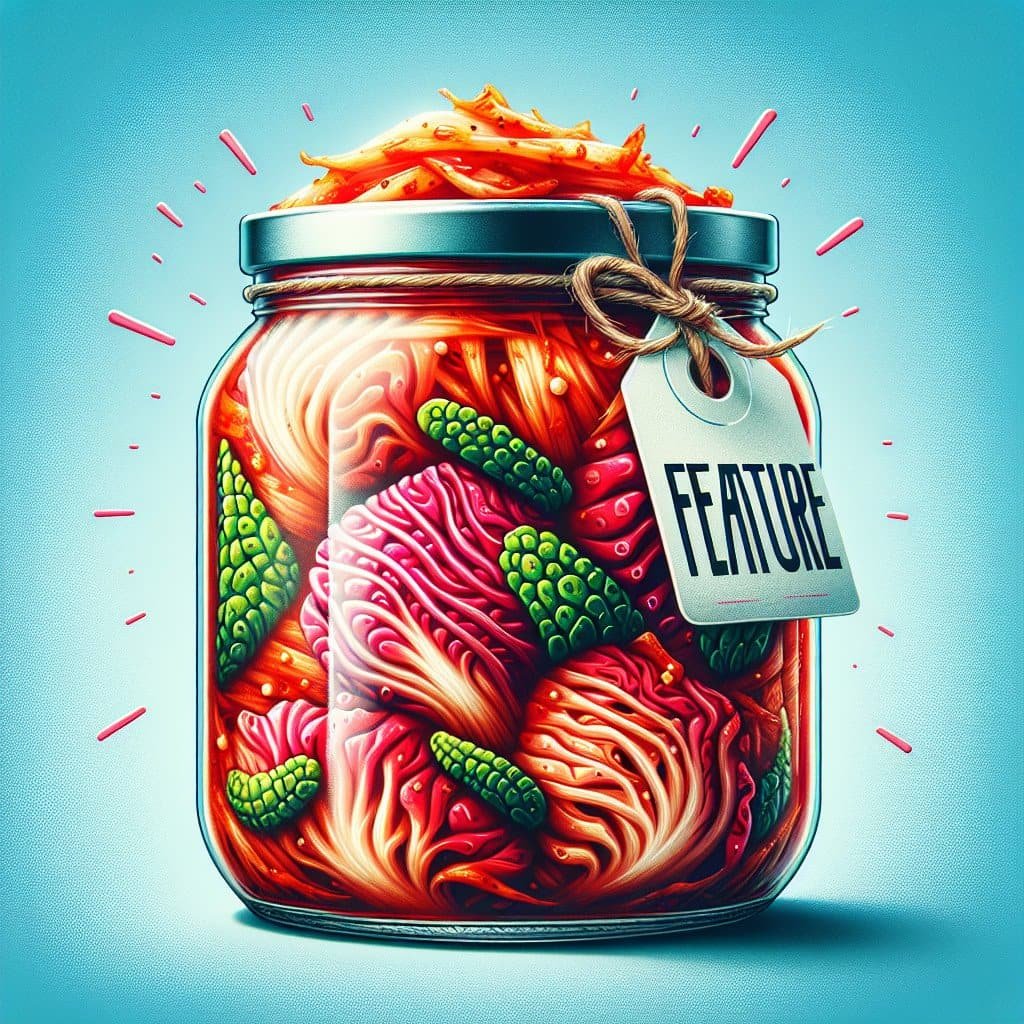Have you ever wondered about the latest trends in incorporating Korean ingredients into probiotic-rich dishes? From kimchi to gochujang, these traditional flavors and ingredients have been gaining popularity in the culinary world. In this article, we will explore the current trends in using Korean ingredients to create delicious and healthy probiotic-rich dishes that are not only good for your gut but also packed with flavor. So get ready to embark on a gastronomic adventure as we delve into the exciting world of Korean cuisine and probiotics!

1. Fermented Foods as a Health Trend
1.1 The Rise of Probiotic-rich Dishes
In recent years, there has been a significant rise in the popularity of probiotic-rich dishes, with fermented foods taking the spotlight as a health trend. Probiotics are live bacteria and yeasts that are beneficial for our digestive system. They help maintain a healthy balance of good bacteria in our gut, which is essential for overall well-being. Korean ingredients have played a crucial role in this trend, as they offer a diverse range of fermented foods that not only promote gut health but also add unique flavors to various recipes. From the iconic kimchi to tangy rice wine and spicy fermented condiments, Korean cuisine has become synonymous with probiotic-rich dishes.
1.2 Health Benefits of Fermented Foods
The consumption of fermented foods has been associated with numerous health benefits. Fermentation aids in breaking down complex sugars and other components in food, making it easier to digest and absorb nutrients. Additionally, fermentation enhances the bioavailability of certain vitamins and minerals, making them more accessible to our bodies. The beneficial bacteria found in fermented foods play a crucial role in improving gut health by balancing the microbiome, supporting digestion, and boosting the immune system. Studies have also suggested that fermented foods may have a positive impact on weight management, heart health, and mental well-being. As a result, incorporating fermented foods into your diet, especially Korean probiotic-rich dishes, can contribute to a healthier lifestyle.
1.3 Increasing Popularity of Korean Ingredients
Korean cuisine has gained immense popularity in recent years, and along with it, the demand for Korean ingredients has soared. People are increasingly seeking out Korean spices, condiments, and fermented foods to enhance the flavor and nutritional value of their meals. Kimchi, one of the most well-known Korean fermented dishes, has become a staple in many households outside of Korea. Its unique combination of spicy, sour, and umami flavors appeals to a wide range of palates. Other Korean ingredients such as gochujang, doenjang, makgeolli, and jeotgal have also found their way into international markets and kitchens, further fueling the use of Korean ingredients in probiotic-rich dishes.

2. Key Korean Ingredients in Probiotic-rich Dishes
2.1 Kimchi – the Iconic Korean Fermented Dish
Kimchi is undoubtedly the most iconic Korean fermented dish. It is made by fermenting vegetables, most commonly napa cabbage, with a variety of seasonings, including gochugaru (Korean red chili pepper flakes), garlic, ginger, and fish sauce. The fermentation process gives kimchi its signature tangy and spicy flavor. Kimchi is not only delicious but also packed with probiotics, vitamins, and antioxidants. It is often consumed as a side dish, but its versatility allows it to be used as an ingredient in various recipes, such as kimchi fried rice, kimchi pancakes, and kimchi stews.
2.2 Gochujang – A Spicy Fermented Condiment
Gochujang is a hot and savory fermented condiment that adds depth and heat to a wide range of dishes. It is made from red chili peppers, glutinous rice, fermented soybeans, and salt. The combination of these ingredients gives gochujang its distinct sweet, spicy, and umami flavors. Besides being a versatile ingredient in Korean cuisine, gochujang also provides probiotic benefits due to the fermentation process. Its rich flavor makes it an excellent addition to marinades, dressings, and stir-fries, adding a unique depth of flavor while promoting gut health.
2.3 Doenjang – Traditional Soybean Paste
Doenjang, a traditional Korean soybean paste, is another key ingredient in probiotic-rich dishes. It is made by fermenting soybeans with salt and Aspergillus oryzae, a fungus responsible for the fermentation process. Doenjang has a deep and rich flavor and is often used as a base for soups and stews. Its fermentation process enhances its probiotic content, making it an excellent addition to any diet focused on promoting gut health. Doenjang can bring an authentic Korean flavor to dishes like doenjang jjigae (soybean paste stew) and doenjang-glazed vegetables.
2.4 Makgeolli – A Tangy Rice Wine
Makgeolli is a traditional Korean rice wine that has gained popularity as a probiotic-rich beverage. It is made from fermented rice, water, and a starter culture called nuruk. The fermentation process gives makgeolli its unique tangy flavor and slightly fizzy texture. Makgeolli is not only refreshing but also contains live cultures that contribute to a healthy gut. It is often enjoyed on its own or used as an ingredient in cocktails and desserts, adding a distinct Korean flair to probiotic-rich recipes.
2.5 Jeotgal – Fermented Seafood
Jeotgal refers to a variety of fermented seafood commonly used in Korean cuisine. It is made by salting and fermenting seafood, such as shrimp, anchovies, and oysters. The fermentation process enhances the umami flavors and creates a complex taste profile. Jeotgal adds depth and richness to dishes like kimchi stew, bibimbap, and stir-fries. While it is an acquired taste, the probiotic benefits obtained from jeotgal consumption make it a valuable ingredient for those seeking to improve their gut health.
2.6 Kombucha – A Korean Twist on Fermented Tea
Kombucha, although not exclusively Korean, has gained popularity as a probiotic-rich beverage with a Korean twist. It is made by fermenting sweetened tea using a symbiotic culture of bacteria and yeast (SCOBY). The fermentation process converts the sugar in the tea into beneficial acids and enzymes, resulting in a tangy and slightly effervescent drink. Various flavors of kombucha, often infused with Korean ingredients like ginger or fruit, offer a refreshing way to incorporate probiotics into your diet.
2.7 Yogurt and Korean Strains
Yogurt has long been recognized for its probiotic properties due to the live cultures it contains. In recent years, there has been a surge in the use of Korean strains of bacteria to make yogurt. Korean yogurt strains, such as Lactobacillus plantarum and Lactobacillus rhamnosus, are known for their ability to survive the digestive process and provide maximum benefits to the gut. Incorporating these Korean strains into yogurt not only adds a unique flavor but also enhances the probiotic content of the yogurt.
2.8 Other Korean Fermented Ingredients
Apart from the key Korean ingredients mentioned above, there are several other fermented ingredients that contribute to the probiotic-rich culinary landscape of Korean cuisine. These include soy sauce, soybean paste, rice vinegar, fermented black garlic, and fermented bean curd. Each of these ingredients offers its own distinct flavors and probiotic benefits, making them valuable additions to a diverse range of probiotic-rich dishes.
2.9 Fusion of Korean and Western Probiotic Dishes
One of the fascinating trends in probiotic-rich dishes is the fusion of Korean and Western flavors and techniques. Chefs and home cooks alike are experimenting with incorporating Korean ingredients into traditional Western dishes to create unique and gut-healthy recipes. Examples include using kimchi in burgers, gochujang in barbecue sauces, and kombucha in salad dressings. These innovative combinations offer a delightful fusion of flavors while capitalizing on the probiotic benefits of Korean ingredients.

3. Incorporating Korean Ingredients in Probiotic-rich Recipes
3.1 Kimchi Pancakes – A Delicious Fermented Twist
Kimchi pancakes, also known as kimchijeon, are a popular Korean dish that incorporates the probiotic-rich benefits of kimchi. The fermented cabbage adds a tangy and spicy flavor to the savory pancakes, creating a unique twist on a classic dish. Enjoy kimchi pancakes as a snack or serve them as an appetizer with a side of gochujang dipping sauce for an explosion of flavors and probiotics.
3.2 Bibimbap with Fermented Toppings
Bibimbap, a traditional Korean rice dish, can be elevated with the addition of fermented toppings. Incorporating fermented vegetables like radish kimchi or cucumber kimchi into your bibimbap not only adds probiotics but also enhances the overall flavor profile of the dish. These fermented toppings provide a refreshing and crunchy element to the bowl of rice, vegetables, and protein.
3.3 Gochujang Dressings and Marinades
Gochujang, with its spicy and savory flavors, is an excellent ingredient for creating probiotic-rich dressings and marinades. Combine gochujang with ingredients like sesame oil, rice vinegar, garlic, and honey to create a flavorful dressing for salads or a marinade for meats. The fermentation process of gochujang enhances its probiotic content, making it a valuable addition to any dressing or marinade that promotes gut health.
3.4 Doenjang Stews and Soups
Doenjang, the traditional Korean soybean paste, is often used as a base for stews and soups. Its deep and rich flavor adds complexity to these dishes while providing probiotic benefits. Doenjang jjigae, a hearty stew made with doenjang, tofu, vegetables, and meat, is a prime example of a probiotic-rich dish that satisfies both the taste buds and the gut.
3.5 Makgeolli Cocktails – Fizz with Probiotics
Makgeolli, the tangy rice wine known for its probiotic content, can be transformed into refreshing and gut-healthy cocktails. Combine makgeolli with fresh fruit juice, herbs, and a hint of sweetness to create fizzy and probiotic-rich beverages. These makgeolli cocktails offer a delightful twist on traditional cocktails while providing the added benefits of probiotics.
3.6 Jeotgal Side Dishes and Seasonings
Jeotgal, the fermented seafood condiment, can be used to create flavorful side dishes and seasonings. Sprinkle a small amount of jeotgal over steamed vegetables or mix it with sesame oil and vinegar for a tangy dressing. The umami flavors of jeotgal add depth and complexity to any dish, while also contributing to a healthy gut due to its probiotic properties.
3.7 Kombucha Mocktails – Refreshing and Gut-healthy
Kombucha, a fermented tea known for its probiotic content, can be transformed into delicious mocktails. Combine kombucha with fresh fruit, herbs, and a touch of sweetness to create refreshing and gut-healthy drinks. These kombucha mocktails offer a way to enjoy the probiotic benefits of kombucha while enjoying a non-alcoholic beverage packed with flavor.
3.8 Probiotic-rich Yogurt with Korean Flavors
Yogurt, a probiotic powerhouse, can be enhanced with Korean flavors and strains to create a unique and health-promoting snack or breakfast option. Incorporate Korean ingredients such as gochujang, doenjang, or traditional Korean fruits like persimmons or jujubes into your yogurt. These additions not only provide a distinct Korean taste but also increase the probiotic content of the yogurt.
3.9 Probiotic Kimchi Fried Rice
Give your fried rice a probiotic boost by incorporating kimchi into the recipe. The tangy and spicy flavors of kimchi infuse the fried rice with a delightful twist while adding beneficial bacteria to the dish. Kimchi fried rice is a perfect example of how you can incorporate Korean ingredients into a classic dish to create a fusion of flavors and health benefits.
3.10 Fermented Ingredients in Kimchi Tacos
Kimchi tacos have become a beloved fusion dish that combines Korean flavors with Mexican cuisine. By incorporating kimchi and other fermented ingredients, such as gochujang or pickled vegetables, into a taco filling, you create an explosion of flavors and probiotics. These probiotic-rich tacos provide a unique and gut-healthy twist to traditional tacos.

4. Creative Presentations and Innovations
4.1 Probiotic Food Trucks
Food trucks have become a popular way to showcase innovative and exciting culinary creations. Probiotic food trucks focusing on Korean ingredients have emerged, offering a range of dishes and beverages that promote gut health while delighting the taste buds. These food trucks provide a convenient way for people to incorporate probiotic-rich Korean ingredients into their diets, even on the go.
4.2 Korean-inspired Probiotic Bowls
Probiotic bowls have gained popularity as a convenient and nutritious meal option. By incorporating Korean ingredients like kimchi, gochujang, and fermented vegetables into these bowls, you can add a unique and flavorful twist while boosting the probiotic content. These Korean-inspired probiotic bowls offer a balanced and gut-healthy meal option that is both delicious and nutritious.
4.3 Fermented Desserts with Korean Flair
Desserts are not typically associated with probiotics, but incorporating fermented ingredients into sweet treats can offer both flavor and health benefits. By using Korean fermented ingredients like rice vinegar, kombucha, or fermented black garlic, you can create desserts that are not only indulgent but also contribute to a healthy gut. These fermented desserts with a Korean flair offer a unique and unexpected twist on traditional sweet treats.
4.4 Probiotic-rich Kimchi Sushi Rolls
Sushi rolls are a versatile dish that can be customized with various fillings and flavors. By incorporating probiotic-rich kimchi into sushi rolls, you add a tangy and spicy twist while reaping the benefits of fermented foods. These probiotic-rich kimchi sushi rolls offer a unique combination of Korean and Japanese flavors that are both delicious and gut-healthy.
4.5 Picklebacks with Korean Fermented Shots
Picklebacks, a popular drink combining a shot of whiskey followed by a shot of pickle brine, can be infused with Korean fermented shots for a probiotic-rich twist. By replacing traditional pickle brine with fermented Korean ingredients like kimchi juice or gochugaru-infused brine, you create a flavorful and gut-healthy beverage. These Korean fermented picklebacks provide a unique and health-conscious alternative to traditional alcoholic shots.
4.6 Probiotic-rich Beauty Products with Korean Ingredients
The health benefits of Korean probiotic-rich ingredients are not limited to the kitchen. The beauty industry has started incorporating these ingredients into skincare and beauty products. Products like probiotic-infused facial creams, serums, and sheet masks that use Korean strains of bacteria are gaining popularity. These beauty products offer a holistic approach to health and well-being by nourishing the skin with beneficial bacteria.
4.7 Fermented Snacks for On-the-go Probiotics
As people lead busy lives, the demand for convenient and nutritious on-the-go snacks has increased. Fermented snacks made with Korean ingredients like dehydrated kimchi chips, fermented nut mixes, or seaweed snacks offer a probiotic-rich and convenient option. These fermented snacks provide a flavorful and gut-healthy alternative to traditional processed snacks.
4.8 Probiotic Taprooms with Korean-inspired Drinks
Taprooms specializing in probiotic-rich beverages have become a popular trend. These taprooms feature a variety of fermented drinks, including kombucha, makgeolli, and other Korean-inspired probiotic beverages. Such taprooms offer unique and creative drink options that promote gut health while providing a delightful experience for the taste buds.
4.9 Korean Probiotic Workshops and Classes
To educate and promote the benefits of Korean probiotic-rich ingredients, workshops and classes are being organized. These workshops allow participants to learn about the fermentation process, explore different Korean ingredients, and create their own probiotic-rich dishes. By providing hands-on experiences, these workshops and classes encourage individuals to incorporate Korean ingredients into their diets and explore the world of probiotics.
4.10 Probiotic Kimchi Dips and Sauces
Kimchi is an excellent base for creating probiotic-rich dips and sauces. By blending kimchi with ingredients like Greek yogurt, mayonnaise, or cream cheese, you can create flavorful and gut-healthy condiments. These probiotic kimchi dips and sauces can be a delicious accompaniment to a wide range of dishes, from raw vegetables to grilled meats.

5. Health Benefits and Future Directions
5.1 Gut Health and Digestive Benefits
The consumption of Korean probiotic-rich dishes offers numerous health benefits, particularly for gut health. The live cultures present in fermented foods help maintain a healthy balance of bacteria in the gut, aiding digestion and promoting overall digestive health. By incorporating Korean ingredients into probiotic-rich recipes, you can support a healthy gut microbiome and potentially alleviate digestive issues.
5.2 Enhancing Immunity with Korean Probiotics
Probiotics have been closely associated with boosting the immune system. Korean probiotic-rich ingredients, with their diverse and potent strains of beneficial bacteria, are believed to contribute to stronger immunity. By incorporating these ingredients into your diet, you can potentially enhance your immune response and improve your overall well-being.
5.3 Potential Weight Management Effects
Several studies have suggested that the consumption of fermented foods may have a positive impact on weight management. The beneficial bacteria and bioactive compounds found in Korean probiotic-rich ingredients may influence metabolism and aid in weight loss. By incorporating these ingredients into your diet, alongside a balanced meal plan and regular exercise, you may support your weight management goals.
5.4 The Rise of Fermentation Science and Research
The growing interest in probiotic-rich dishes has led to an increased focus on fermentation science and research. Scientists and researchers are exploring the benefits of different strains of bacteria, fermentation techniques, and the impact of fermentation on nutrition and health. This research aims to uncover new ways to harness the probiotic potential of Korean ingredients and develop innovative probiotic-rich products.
5.5 Exploring New Sources of Probiotic-rich Korean Foods
As the demand for probiotic-rich Korean ingredients increases, there is a push to explore new sources of fermentation. Researchers and chefs are experimenting with different vegetables, fruits, and grains to create unique probiotic-rich foods. By exploring new sources of probiotic-rich Korean foods, we can expand the variety of options available and further promote gut health.
5.6 Food Safety and Quality Assurance
As the popularity of probiotic-rich Korean ingredients grows, ensuring food safety and quality becomes paramount. Producers and manufacturers must adhere to strict guidelines to maintain the quality and integrity of fermentation processes. Promoting food safety and quality assurance measures ensures that consumers can confidently incorporate probiotic-rich Korean ingredients into their diets.
5.7 Incorporating Probiotics in Traditional Korean Cuisine
As probiotics become a staple of modern diets, there is a movement to incorporate probiotics into traditional Korean cuisine. By preserving and adapting traditional fermentation techniques, chefs and home cooks can elevate classic Korean dishes with probiotic-rich ingredients. This integration of probiotics into traditional Korean cuisine not only preserves culinary heritage but also enhances the nutritional value of these dishes.
5.8 Global Impact and Influence of Korean Probiotic Foods
Korean probiotic foods have made a significant global impact, influencing not only culinary trends but also the health and wellness industry. The unique flavors and health benefits offered by Korean probiotic-rich ingredients have captured the attention of people worldwide. As Korean cuisine continues to gain popularity, the global influence of Korean probiotic foods is expected to grow, inspiring new culinary creations and promoting overall well-being.
5.9 Farm-to-Table Practices with Korean Ingredients
The farm-to-table movement has taken the culinary world by storm, emphasizing the use of locally sourced and fresh ingredients. As Korean probiotic-rich ingredients become more popular, the importance of sustainable and organic farming practices gains prominence. Farm-to-table practices ensure the quality and integrity of Korean ingredients, providing consumers with the best possible probiotic options.
5.10 Collaborations and Fusion of Traditional and Modern Fermentation Techniques
The future of Korean probiotic-rich dishes lies in collaborations and the fusion of traditional and modern fermentation techniques. By combining knowledge and expertise from different culinary traditions, chefs and scientists can create innovative probiotic-rich dishes that appeal to a wide range of tastes. These collaborations will continue to push the boundaries of fermentation science and provide exciting new options for incorporating Korean ingredients into probiotic-rich recipes.
In conclusion, the current trends in using Korean ingredients in probiotic-rich dishes are driven by the rise of interest in gut health and the diverse culinary flavors of Korean cuisine. Key Korean ingredients like kimchi, gochujang, doenjang, and makgeolli offer a range of probiotic benefits while adding unique flavors and depth to various recipes. From incorporating Korean ingredients in classic dishes to creating innovative fusion recipes, there are countless ways to explore and enjoy the health benefits of Korean probiotic-rich foods. As the field of fermentation science advances and collaborations between culinary traditions continue to evolve, the future of Korean probiotic-rich dishes looks promising, with potential impacts on global culinary trends and the overall well-being of individuals.
